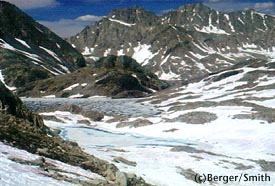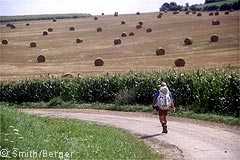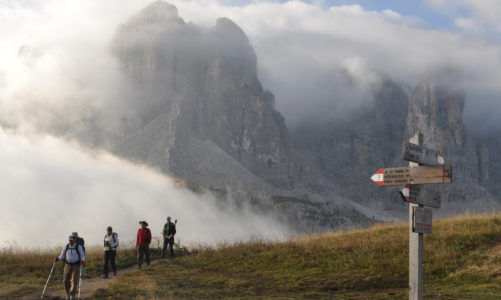Mountain goats have special suction cup like hooves that grip onto rock and enable them to climb on ledges as precipitous as skyscrapers. We hikers do not.
So while the high mountains of legendary ranges such as the Alps, Rockies, and Cascades attract us with an almost palpable magenetic force, we need a little know-how to get around some of the obstacles we’ll encounter. Indeed, some high-mountain trails may be little more than cross-country routes, sometimes marked by cairns, and sometimes not marked at all. The rocky, rubbly high-country paths twist knees and ankles, challenge balance, and can make the distance of a mile seem to stretch for two or three.
 |
| Rocky terrain in the Pyrenees is a challenge for hikers. |
This can be an important consideration when you’re planning your daily mileage and campsites, because travel times on boulders and rocks can drop to little more than a mile an hour.
Traveling on Scree
Scree is the fine, crumbly crushed and eroded rock that slides underfoot, making it seem that the hiker is going up the down elevator. Often, each step up the mountain is accompanied by a corresponding slide down.
When climbing on scree, look for a zigzag path and avoid facing the slope head-on. This helps eliminate the sliding problem typical of a direct assault up a steep scree slope. The mini-switchbacks are also easier on the legs, and require less brute force (to lift bodies and packs) and less stretching of the calves (caused by putting the foot down on a steeply angled slope).
On very steep and narrow slopes, making switchbacks may not be practical. In such cases, the hiker has two options:
- Kick steps into the scree. This works if the scree is a few inches deep. Dig in with the front of the boot, test to be sure the footing is stable, then shift weight and repeat on the other foot.
- Look for larger rocks that appear to have come to rest at a stable angle of repose (the place at which friction, angle, and gravity all come into balance and an object stops following gravity’s imperative to keep sliding downhill). If these rocks are stable enough, they may be able to hold a hiker’s weight. Test your footing before committing any weight.
Descending on scree is a bit faster -– sometimes too fast. The quickest technique down a scree slope is called screeing, which is a little like skiing on hiking boots. The deeper the scree, the better. Limit this technique to slopes with few obstacles, because big boulders can be difficult to steer around. The basic technique is to bend the knees, then launch into a sort of slow-motion combination jog and slide. Hopping from foot to foot helps with balance, as do trekking poles. Gaiters keep scree out of the boots. If you’re not wearing them, you’ll end up with a boot full of rock junk.
Alpine Trekking Through Talus
Talus comprises chunks of rock. It is the larger rubble that often is found on mountain slopes, especially at the base of cirques and bowls.
The biggest challenge in traveling on talus is to keep in balance. Often, boulders are irregularly shaped and pointy, and sometimes, they move underfoot. Walking on and around them can involve big steps up, down, and sideways. Keep knees bent and balance low, and, as with skiing moguls, always look several steps ahead. It is often easier to step down slightly sideways than straight down forward. Going straight forward puts more stress on the knees and forces your balance (sometimes too far) forward. The easiest progress involves a fluid but controlled movement from rock to rock.
Hikers picking their own route up or down a talus slope should look for cairns, small piles of stones that are made by trail planners or other hikers, and which often show the easiest way through the maze.
When cairns are not available, pick a diagonal route rather than going straight up and down. The straight-up route may be more direct, but it is more difficult to travel straight up or down on talus, The direct route is is harder on both knees and balance, takes more energy and concentration, and can put hikers below in danger of being hit by dislodged and falling rock.
Hiking sticks or trekking poles are the alpine traveler’s best friend (unless the landscape is covered in snow, in which case, that honor goes to the ice axe). Trekking poles can help a hiker maintain balance and take pressure off the knees, especially when hiking downhill, and particularly on talus.
My most sage advice: Trek slowly, rest often, and be sure to stop often enough to look up from your feet and take in the views.



